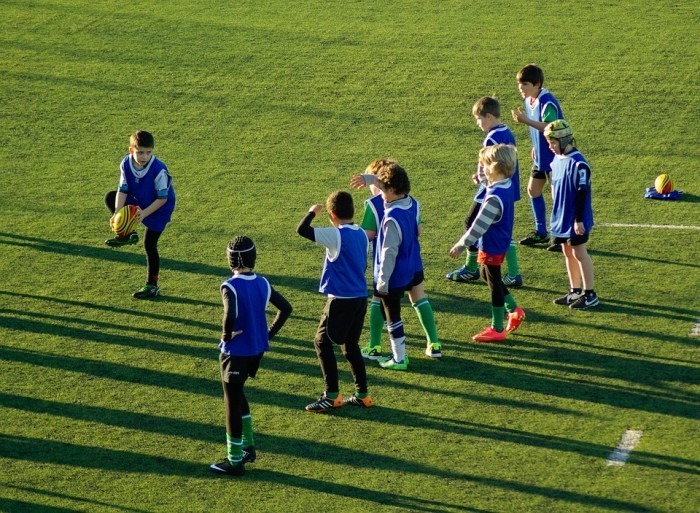
Is Rugby Really Dangerous? Let’s Discuss 5 Myths About Rugby!
Every year, the Hong Kong Sevens rugby tournament attracts a large number of tourists from all over the world who come especially to enjoy this exciting sport. Whilst in the past rugby was not a particularly popular sport in Hong Kong, many local Hong Kong people have now also started to take an interest in rugby. As a result, there are now a variety of rugby classes available for kids in Hong Kong. Although rugby seems to be a lot of fun for kids, rugby matches are fast-paced and involve a lot of physical contact. Many parents are wary about letting their kids play rugby because they are worried about the injuries they might sustain.
Every sport runs the risk of causing injury, and rugby is no exception. However, children’s rugby classes are not as dangerous as some might imagine. We will take a look at some of the myths about rugby classes, so that everyone can take the first step towards deciding whether to try out and enjoy the fun of playing rugby.
Myth #1: Rugby players need to put on protective wear and helmets because the sport is very dangerous
Wearing thick protective wear and bulky helmets is a requirement of American football. Rugby players are not required to wear protective pads and helmets. As there is more physical contact in playing American football than playing rugby, American football players need more protection.
Rugby players are not required to wear protective pads and helmets.
Myth #2: Rugby players are often knocked to the ground
Rugby can generally be played in two different formats: touch rugby and tackle rugby. In formal rugby matches, it is usually tackle rugby that is played. As the name implies, physical impact is inevitable in tackle rugby matches.
However, for many rugby classes – especially those for children under the age of 8 – touch rugby is the format used. Touch rugby was originally used as entry-level training for those just starting to learn how to play rugby, but it has gradually become the main approach for children’s rugby training. The rules of touch rugby and tackle rugby are entirely different. With touch rugby, players just need to touch their opponent’s body lightly and shout "Touch!" to intercept their opponent’s offensive. In touch rugby, players do not have a substantial physical contact with each other, so it is relatively safe for children.
Players aged 8 and over can start to try tackle rugby. Parents need not be scared off by the words “tackle rugby”. Collisions and physical contact do not necessarily result in injuries because there are many rules to protect players. For example, when intercepting, players cannot touch their opponents above the shoulder. Also, many formal rugby classes will first teach players how to protect themselves. Although physical contact cannot be avoided, the impact can still be minimized. For example, when intercepted, one of the basic skills players learn in tackle rugby is to first bend their knees and lower their center of gravity to land on their bottoms. In interviews, a number of players on the junior Hong Kong rugby team have also said that they have rarely received any injuries during their rugby career. Like with most other sports, the injuries they do sustain are mostly superficial injuries such as bruises and abrasions. If necessary, some rugby players may wear soft headguards and mouthguards to provide extra protection.
Myth #3: Rugby is only suitable for kids who are big and tall
The team players have different physiques in the same team.
Because many parents believe that rugby involves a lot of collisions between players, they are of the impression that only children who are robustly built can become outstanding rugby players. In fact, like with other team sports, children of different physiques also have different advantages when taking on different roles in the team. Rugby positions are mainly divided into the forwards and the backs. The forwards usually have relatively tall physiques as they are the ones who need to break through the opposing team’s defense. Players of medium stature are well-suited to the backs positions because the backs must be highly flexible and able to run fast in order to help move the ball towards a goal. The organizational and teamwork requirements of rugby highlight the importance of having team members of different physiques and roles.
Myth #4: Rugby is only suitable for children who are very athletic
As rugby is a high intensity ball sport, it is often mistakenly thought of as a sport only for kids with a high level of athletic ability. In fact, compared with other sports, playing rugby is relatively simple. Compared to sports which require rackets (such as badminton), where players need to focus on using a racket as well as running, rugby mainly just involves running. Compared to other ball sports such as football and basketball, rugby only requires players to hold a rugby ball whilst running forward to the opposing team’s end zone (rather than having to dribble the ball continuously). A rugby coach has said that playing rugby is a bit like playing hide and seek – if you don’t let others get hold of the ball as you run run it to the end zone, you will win. Rugby is a game that requires less hand-foot coordination than other sports. It may even be easier for children to derive a sense of satisfaction from rugby than other ball games.
Myth #5: Rugby is only suitable for boys
Girls can also play an important role in rugby matches. As mentioned above, players who are smaller in stature may be more nimble and well-suited to taking on defensive positions. Girls may also have the same advantage. Girls who can run nimbly take on important roles in co-ed as well as all-girls’ touch rugby games.
Whizpa has listed over 25 different rugby class providers in different districts of Hong Kong. If your child has tried any rugby classes, please leave a review of the classes on Whizpa to contribute to the development of sports education in Hong Kong!








